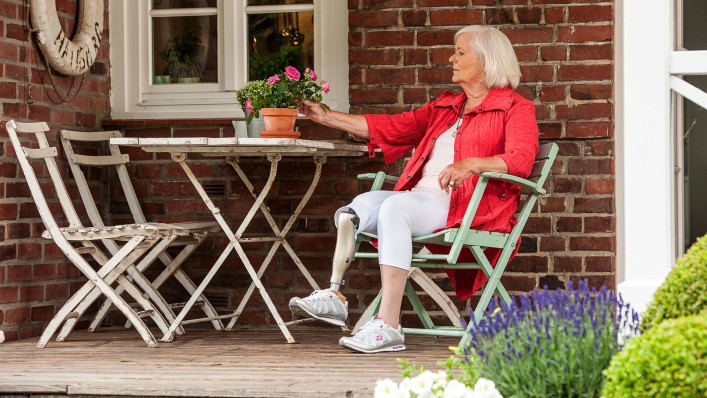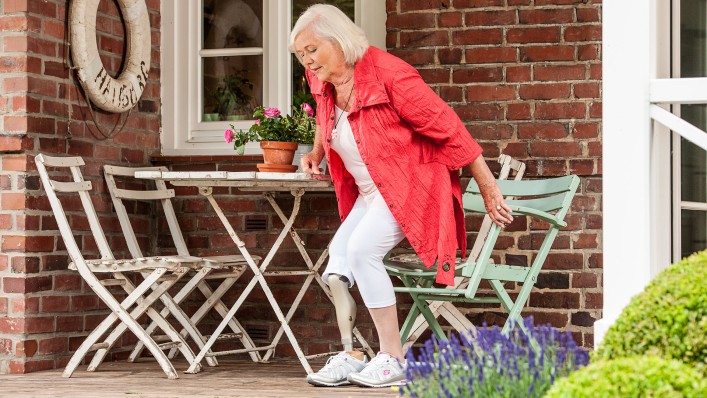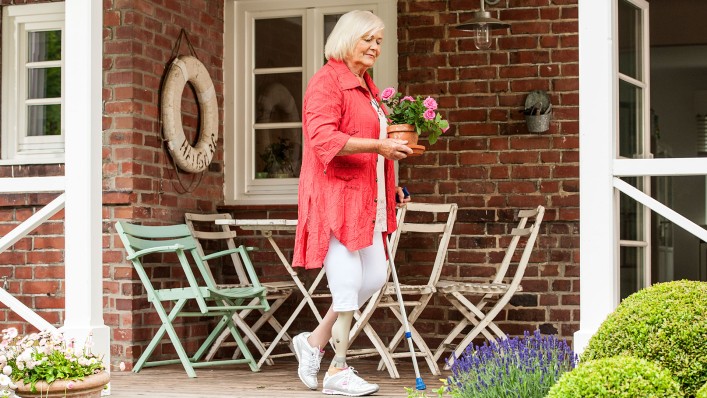Kenevo
Reclaim your sense of security.
Benefits at a glance

Supported sitting down
The Kenevo automatically detects when you sit down and supports you. Even if your movement is slow, you stay in control, because the joint bends accordingly slowly. This feature makes the Kenevo a very stable leg prosthesis. You can hold on to the chair or a walking aid with your hands while sitting down.

Wheelchair function
Sitting and manoeuvring in a wheelchair becomes easier when the wheelchair function is enabled thanks to the additional ground clearance of the prosthetic foot. With only one hand movement, the knee joint can be locked between a slightly bent position and an almost stretched leg. This prevents the leg prosthesis from getting caught on the ground.

Supported standing up
While standing up, it is possible to put weight on the Kenevo. Even if you need to pause again, this is not a problem - the leg prosthesis reacts immediately and allows a pause with the knee flexed. This is a function for balance and stability.

Stance function
Independently of the selected activity mode, the Kenevo provides the highest possible safety for standing. In activity modes A and B, safety is guaranteed by the locked stance phase. The stance phase refers to the moments where you stand on the floor with the prosthesis. In the more dynamic activity mode C, stable standing is possible thanks to the intuitive stance function even with the knee flexed.

Stumble recovery plus
Carpet edges, thresholds or other tripping hazards should not be an obstacle. Thanks to the stumble recovery plus feature, the Kenevo recognises if you stumble and are at risk of falling or stop a movement. The knee joint then switches immediately into a high flexion resistance.

Unique swing phase initiation
The swing phase refers to the phase of walking, where the prosthesis swings through during the heel-toe gait of the other leg on the ground. In activity modes B and C, the swing phase triggers reliably even for small steps and at varying load, e.g. by walking aids. Even when walking very slowly, there will remain enough clearance to ground while swinging through. All this ensures high safety.
Functionality
The Kenevo has three activity modes. This gives it an extraordinary ability to adapt to your individual needs and developing skills, for example during rehabilitation. Your O&P professional adjusts the activity mode suitable for you on the knee joint.
Mode A: locked mode
In mode A, the Ottobock knee joint is locked and does not initiate a swing phase. Thus, the Kenevo, as a stable prosthesis, provides maximum safety and does not allow unexpected movements.
Therefore, locked mode is suitable if you have little control over your residual limb, typically walk only short distances indoors and spend most of your time sitting.
Mode B: semi-locked mode without stance phase flexion
In this mode B, the joint is locked during the entire stance phase. It unlocks for the swing phase, i.e. when you start the pendulum movement of your leg. This is largely independent of your gait pattern and whether you are using other walking aids. The Kenevo initiates the swing phase always at the right time.
This activity mode is especially useful if you have medium control over your residual limb, cover short distances and walk slowly.
Mode B+: semi-locked mode with stance phase flexion
This activity mode corresponds to the mode B, but is supplemented by a stance phase flexion at heel strike of up to 10°. While this sounds technical, it basically means that you can walk on moderate slopes. As soon as your heel hits the ground, the knee bends slightly. This results in a movement that looks more natural.
This activity mode is suitable if you have already built enough confidence in your prosthesis in order to walk with stance phase flexion.
Mode C: yielding mode
A more natural walking with the same high level of safety can be reached in the yielding mode. In comparison to the other activity modes, the stance phase in mode C is not locked, but exhibits a high level of damping. This helps you go with the transfemoral prosthesis on level ground, slopes and stairs. The swing phase can be initiated earlier, which facilitates the more dynamic movements.
Activity mode C is suitable for you if you have moderate control over your residual limb, are able to deal with various everyday situations and can cover short to medium walking distances outdoors.
Ideal prosthetic components

Terion K2
The Terion K2 is a reliable everyday companion, especially for users with high safety needs. The prosthetic foot provides stability and safety while walking and standing in everyday life, both at home and out and about.

Dynamic foot
The highly natural 1D10 and 1D11 Dynamic prosthetic feet feature a high level of functionality and are visually appealing thanks to shaped toes.

Trias
Based on the natural model, the 1C30 Trias prosthetic foot features a strikingly attractive appearance in addition to very comfortable mobility.
Downloads

- download 1.97 MB | PDF
Information for users
This brochure provides you as the user with complete information about the Kenevo leg prosthesis.

- download 443.51 kB | PDF
Brochure for activity mode A – Kenevo
This brochure provides an introduction to activity mode A.

- download 805.70 kB | PDF
Brochure for activity mode B – Kenevo
This brochure provides an introduction to activity mode B.

- download 865.68 kB | PDF
Brochure for activity mode C – Kenevo
This brochure provides an introduction to activity mode C.



